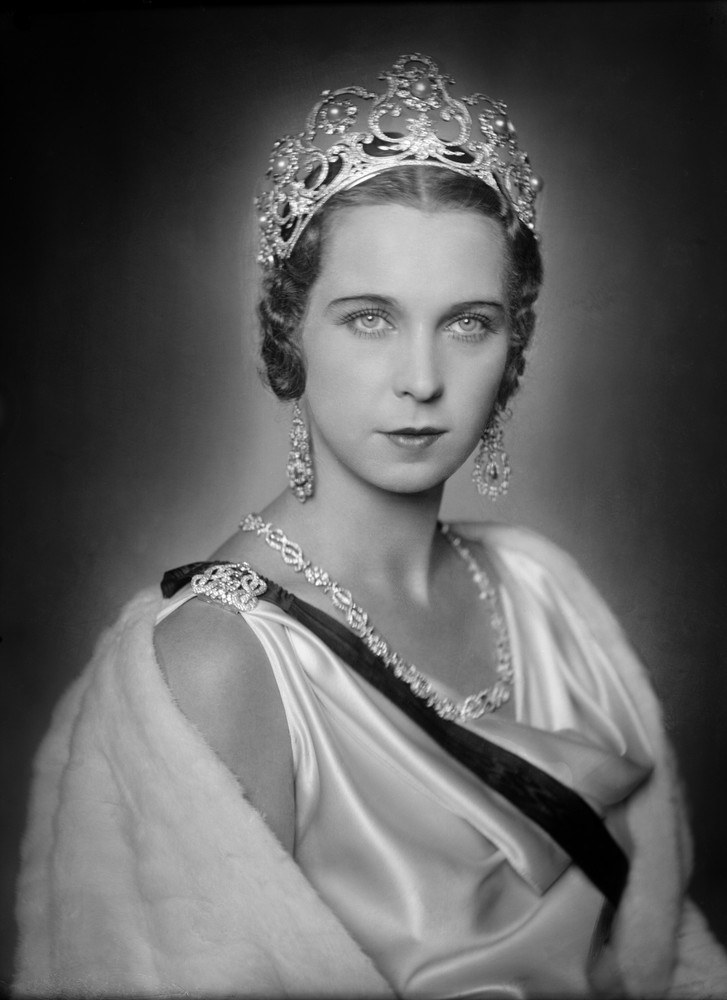So Boring (1906)
“God Save the Queen,” The British National Anthem first performed in 1745, employs the lyric, “Send her victorious/Happy and glorious/Long to reign over us…” In contrast, a European crowned head reigned for only twenty-seven days as “The May Queen.”
The Moirae, the mythological weaving sisters, spun a tapestry that fated a European princess to reign in an ephemeral web. Marie-José Charlotte Sophie Amélie Henriette Gabrielle of Saxony-Coburg was born in the imperial villa near Ostend, Belgium, the only daughter of Albert and his wife, Elisabeth of Bavaria. From her mother’s side, Marie-José was related to Empress Sisi of Austria; she had two brothers, Charles and Leopold. Marie-José found the court stifling. Lady Curzon, a friend from England, recalled of a visit, “The royal children were never allowed to utter a word at meals unless they were addressed by one of their parents.” 
In 1909, Albert succeeded his uncle, King Leopold II, notorious for his ruthless exploitation of the Congo. Five years later, with the German invasion of Belgium during World War I, the family left Brussels and settled in La Penne where King Albert I became the rallying point of his country’s resistance. Queen Elisabeth abandoned her passion for music and devoted herself to nursing wounded soldiers. The royal couple sent their children to safety in England where they first stayed with Lord and Lady Curzon. On occasional visits to spend time with her parents at the Western Front, Marie-José met the French Prime Minister Georges Clemenceau, the Prince of Wales, and the violinist Eugène Ysaÿe. With the return of peace, Marie-José resumed her blue-blood role. For her first ball in 1924, she received a diamond tiara and antique pearl necklace once owned by Stephanie, Grand Duchess of Baden, the first of her many priceless gems.
With a nod to uniting their Roman Catholic kingdoms, the Belgian and Italian sovereigns planned a dynastic marriage between Princess Marie-José and Umberto, Prince of Piedmont. To prepare for her future role, Marie-José attended the College of the Santissima Annunziata, a convent school outside Florence. The Belgian royals visited King Vittorio Emanuele III and Queen Elena at Battaglia, their residence near Padua, in order to introduce their children. The thirteen-year-old Umberto was taken with the thirteen-year-old beauty, and six years later the crown prince arrived in Belgium to formalize their engagement. The following day, Fernando de Rosa, infuriated that the Italian monarchy was colluding with the dictator Benito Mussolini, attempted to assassinate Umberto who had just laid a wreath on the Tomb of the Unknown Soldier.
The royals married in 1930 in Rome’s Pauline Chapel at the Quirinal Palace in one of the grandest gatherings of European royalty ever experienced. The guests, many of whom were former monarchs, led the bride’s father to remark, “There are many unemployed in our trade.” The Duke of York, later King George VI, felt slighted when the King of Italy sent Marie-José’s brother, Prince Charles of Belgium, into dinner ahead of him. He reported to his father, “There’s one thing, Papa, I’ll never go to Rome again!” Marie-José refused to sign her name on the wedding register as Maria Giuseppina, a move expressly against Mussolini’s wishes. Her anti-fascist stance led to her nickname, the rebel queen. Following their nuptials, Umberto and Marie-José had a state audience with Pope Pius XI.
Upon their return from their honeymoon at San Rossore, the couple settled at the Royal Palace in Turin. Unlike her parents who had adored one another, Marie-José later revealed that her marriage was never happy. She loved music and spontaneity while her husband was formal and dedicated to the military traditions of the House of Savoy. Annoyed at Umberto’s deference to protocol, she stated, “It seemed as if we were in China, with all that bowing.” In 1934, with Umberto’s promotion to general, they relocated to Naples to an estate they renamed Villa Maria Pia after the birth of their daughter. Three years later, succession was assured with the arrival of Victor Emmanuel, the Prince of Naples, followed by Maria Gabriella and Maria Beatrice. Parenthood did not erase their incompatibility, and Marie-José confided to journalist Indro Montanelli in 1940, “You know, I don’t have much to do with the House of Savoy. It’s not a family, it’s a Frigidaire.”
Upon the outbreak or war, Marie José was horrified that her royal relatives had become allies of Germany. Following her mother’s example, Marie-José served for a time with the Red Cross, and she accompanied the army on its invasion of Abyssinia (later Ethiopia). Ignoring her father-in-law who demanded, “she keep her nose out of family politics,” under the guise of an archaeological trip to Pompeii, Marie-José held a clandestine meeting with a diplomat at the Vatican, fellow anti-fascist Monsignor Giovanni Battista Montini, the future Pope Paul VI. Determined to release her adopted country from the yoke of tyranny, Marie-José supplied the Italian Resistance with funds and weapons. When the princess saw Allied bombers over Rome, she wrote of them as “white liberating birds.”
Rumor holds it that although Marie-José was repulsed by Mussolini as Il Duce, she was attracted to him, and they engaged in a sexual relationship. In a 1993 interview, when asked about the affair, Marie-José replied, “He was a lion. I, too, am a lion. And we both feared one another.”
Although the princess may have been simultaneously attracted to and repelled by Mussolini, she was unequivocal about her hatred of the Führer. In 1940, Marie-José travelled to Hitler’s Alpine mountain retreat, Berchtesgaden, on the behalf of Belgium, annexed by the Nazis in 1940. Over tea, she pled for food for her starving countrymen and for a more humane treatment for her brother, King Leopold III, imprisoned in Laeken, who had assumed the throne after his father’s death in a climbing accident. The answer to all her requests: “Nein.” However, Hitler, struck with Marie-Josie’s Nordic appearance, complimented her eyes that he described as “the color of the German sky.” She recalled that Hitler ate chocolate throughout their meeting. Marie-José added that if she had brought a gun “she would have had the strength to use it.” The King, angry with his daughter-in-law, banished her to Sant’Anna di Valdieri. After Mussolini’s defeat in 1943, Umberto, Marie-José, and their children fled Rome for Switzerland. She reportedly told friends that she regretted not having joined Italian partisans who fought to oust the swastika.
After the war, King Vittorio Emanuele’s subjects could not forgive him for sleeping with the enemy or for fleeing the country during Italy’s lowest ebb. In a bid to save his throne, he abdicated in favor of his son and took refuge in Egypt, the guest of King Farouk. Umberto II and Queen Marie-José assumed the throne on May 9, 1946. Twenty-seven days later, Italy voted in favor of becoming a republic: 12.7 million to 10.7 million. Thus, the May King, (so called as he assumed the throne in that month), was the last of the line of a dynastic chain that stretched back to the Middle Ages. A devastated Umberto stated that he would accept the decision rather than risk a civil war.
A further kidney punch to the House of Savoy was the new constitution decreed that Umberto, his Queen, son Prince Victor Emmanuel, and any further male descendants were barred from ever setting foot in Italy again. The refugee royals left for Portugal’s “Gold Coast” where they became a part of the denizens of un-throned royalty and bluebloods who found sanctuary in Cascais. Exile did not bring Umberto and Marie-José closer; in 1947, she left for Switzerland. Her new residence was the eighteenth century Château de Merlinge near Geneva where members of the exiled dynasty spent their exile. She spent her time writing and working on instituting the Fondation du prix de composition musicale Reine Marie-José that still awards prizes to talented musicians. In the 1980s, the former Queen was on the move again, this time to Mexico, to live with her youngest daughter, Princess Maria-Beatrice, and her grandchildren. However, North America did not prove her final destination, and she returned to Europe where she stayed with her other children in either France or Switzerland. The Italian government allowed her a bittersweet visit in 1988, in part because of the support she had given to the opponents of Mussolini. Although Umberto had never been able to return to his native land, upon his 1983 passing, he bequeathed the Shroud of Turin to Pope John Paul II.
Although the royal couple had not lived together for the latter part of their lives, when Marie-José passed away from lung cancer in 2001, at age ninety-four, her final resting place was beside Umberto, in France’s Hautecombe Abbey, where they joined other rulers of the House of Savoy. Although the last king of Italy felt his birthright had been stolen, the loss of her royal status did not bring Marie-José the same heartache. As she had once remarked, “Being queen is so boring.”


